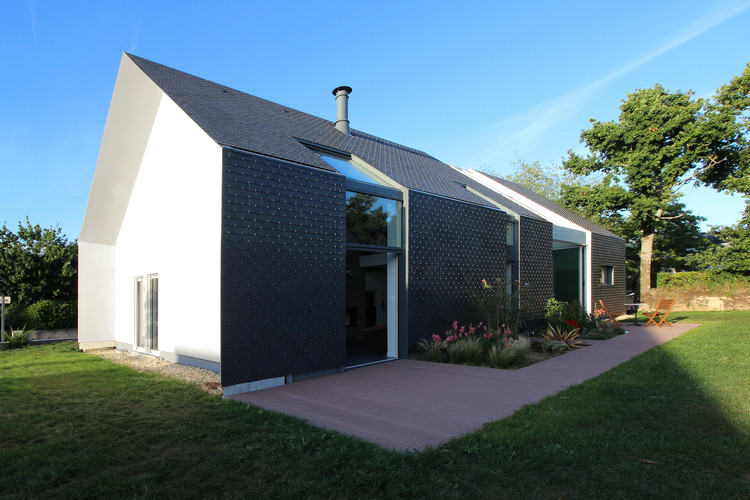
Every child has drawn a house. Perhaps a sunny day with some clouds, a leafy tree, a family with a dog, low wooden fences, or even a car. But in these drawings, they will almost certainly draw a simple rectangle with a gable or hip roof. This archetype of the house appears in virtually all cultures, and even today many architects use it for contemporary projects.
In addition to the primary function of draining rainwater and snow, and thus protecting the building from the weather, roofs can be an important aesthetic device for composing a project. In modern architecture, waterproof roof slabs emerged as a popular alternative, but sloping roofs have continued to captivate both clients and architects. In this article, we will cover the various types of roofs and, more specifically, the manufacturing process and characteristics of natural slate tiles.

When designing a roof, architects can choose from a wide variety of materials. Whether they decide on metallic, ceramic, asphalt, or other tiles can significantly alter the aesthetics of the project, its costs, its thermal characteristics, and even the dimensioning of the support structure. Slate tiles, with their dark colors, subtle variations, and elegant texture, often please many tastes. Slate is a 100% natural product that only goes through the extraction and carving process, requiring no additional treatment and generating no chemical waste. This qualifies it as a sustainable alternative to other material options, since its residues of production are entirely natural; likewise, the original landscape can be completely recovered with native plants in a process supervised and approved by environmental agencies. Slate is a durable and fire-resistant material, ensuring structural security of the roof in the event of a fire. However, an important point to consider is that, as a natural stone, slate is also a heavy material, requiring a robust support structure to hold its own weight. Also, it is always essential, like with any other type of tile, to pay attention to the minimum and maximum angle of inclination.

From the quarry, natural slate must go a long way before it can be installed on a roof. Its manufacturing process is somewhat artisanal. At the quarry site, geologists thoroughly examine the best areas to perform the extraction. The slate is then sawn from the quarry face into large flat slabs using a steel cable and then sliced and transported to the factory. There, the blocks are selected and sawn in different sizes, according to their quality and potential for use. The next step is the molding process, in which smaller blocks are cut one by one by qualified artisans into sheets. Then, the corners of each part are chamfered by a machine and, after a final inspection, are ready for use.



For installation, the slate tiles are applied on the support structure of the roof, potentially over an anti-vapor layer. There are two main ways to install the parts. They can be drilled and "nailed" to the structure, or workers can use small hooks that hold each tile without piercing them. As noted in the examples shown in this article, the material also can finish walls. On roofs, the tile typologies can vary a lot, adapting to the specifics of each project. Below are 10 general types of roofs:

1. Gable roof: the most common type, consisting of two planes that can be symmetrical or asymmetrical. It can include eaves or not. Finally, this type of roof is very functional: it is easy to build, drains water well, facilitates ventilation, and adapts to most architectural projects.

2. Hip roof: also quite common, it is a slightly more complex construction, composed of 4 inclined planes. It is suitable especially for regions with strong winds, as none of the gables represents a barrier to wind passage.

3. Dutch roof: similar to a gabled roof, but with two pronounced planes of inclination. This type of roof provides access to the attic, in addition to adding natural light and extra space.
4. Mansard roof: very common in Paris, this is a roof with four sides constituted by 8 planes, the lower ones being steeply inclined and the upper ones lying almost flat, providing space below the roofing.

5. Flat roof: Most flat roofs are not 100% flat, but slope slightly. This subtle slope allows water to drain better.
6. Shed roof: a unique plan, which provides space for large windows and a high ceiling.

7. Butterfly roof: two planes inclined to a central track. This type of roof provides plenty of light and ventilation, but the detailing of the gutters must be done very well to avoid infiltration problems.

8. Gambrel roof: can be characterized as a gable roof, but with four planes of different slopes. This allows for better use of the internal space in the attic

9. Dormer roof: characterized by roof windows illuminating and increasing the existing space. They protrude and create useful space outside the roof, as well as providing additional natural light and ventilation.

10. M Shaped roof: composed of two or more gabled roofs.

Sloping roofs can do much more than drain water, instead becoming focal points in buildings by blending or standing out in context. Understanding the possibilities of these typologies and materials is vital to making the best choice for each project, combining functionality, aesthetics, and affordability.
Learn more about natural slate roofs on the Cupa Pizarras website.
























